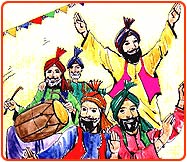Joyful festival of Baisakhi is celebrated with lot of charm and gusto in the vibrant state of Punjab. People perform set Baisakhi customs and traditions for the day with sincerity and devotion. Since Baisakhi is celebrated as the birth of Guru Gobind Singh - the Tenth Sikh Guru and the foundation day of Khalsa Panth, major activities for the festival are centred on gurdwaras - the Sikh place of worship. As a harvest festival Baisakhi is celebrated in open fields with energetic bhangra and gidda dance by gaily dressed men and women of Punjab.
People following Sikh faith wake up early in the morning on a Baisakhi day and pay visit to gurdwaras to attend special prayer meetings. While most Sikhs strive to visit the revered Golden Temple or Anandpur Sahib, where the Khalsa was pronounced, those who are unable to do so visit their neighbourhood gurdwara.
At a gurdwara, the Guru Granth Sahib, the holy book of Sikhs is ceremonially taken out and is given a symbolical bath with milk and water. After these simple rituals, Guru Granth Sahib is placed on its throne with care. The book is then read out to the followers gathered in the gurdwara.
Just as on a Baisakhi Day ceremony held in 1699 under the guidance of Guru Gobind Singh where Panch Pyaras or the Five beloved ones chanted verses, five priests going by that name chant verses recited by the five originals. Similarly, just as Guru Gobind Singh Ji had used amrita prepared in an iron vessel to bless the panch pyare, even to this date amrit or holy nectar is prepared in an iron vessel and is distributed amongst all gathered after the chanting of sacred verses. As a tradition, devotees sip amrita five times and take a vow to work for the brotherhood, the Khalsa Panth. Religious songs (kirtans) are sung after the amrit is drunk for the spiritual upliftment of those gathered.
At noon, after the Baisakhi ardas, the Karah Prasad or sweetened semolina is offered to the guru for his blessings. It is then distributed to the congregation. The ceremony culminates with a special guru-ka-langar or the community lunch. People sit in rows with their heads covered as volunteers serve them with vegetarian meal.
 Later, during the Baisakhi day, sacred Guru Granth Sahib is taken out in a procession. At the head of the procession are the Panj Piaras, symbolizing the journey made by the five fearless devotees from their homes to Anandpur, to be baptised by Guru Gobind Singh. Baisakhi processions are attended by men, women and children alike with faith and enthusiasm. The procession moves through major localities of the city and is welcomed by citizens and members of social and cultural societies. Colourful bhangra and gidda dance apart from mock duels are performed during Baisakhi processions. Another fascinating part of Baisakhi celebrations is the accompaniment of drummers, bands playing religious times, devotees singing religious songs and men swinging swords.
Later, during the Baisakhi day, sacred Guru Granth Sahib is taken out in a procession. At the head of the procession are the Panj Piaras, symbolizing the journey made by the five fearless devotees from their homes to Anandpur, to be baptised by Guru Gobind Singh. Baisakhi processions are attended by men, women and children alike with faith and enthusiasm. The procession moves through major localities of the city and is welcomed by citizens and members of social and cultural societies. Colourful bhangra and gidda dance apart from mock duels are performed during Baisakhi processions. Another fascinating part of Baisakhi celebrations is the accompaniment of drummers, bands playing religious times, devotees singing religious songs and men swinging swords.
Loud Sikh chants of 'Bole so nihal', 'Deg teg fateh' and rhythmic chants of 'Sat nam' and 'Wahe guru' ring out from the middle of the singing and drumming. Some men may wear the headgear (bana) of Guru Nanak, others that of Guru Gobind Singh.
In their discourse at the end of the ceremony, Sikh religious leaders strive to promote the feeling of charity amongst people, especially children in honor of Guru Gobind Singh.
In some places, especially Punjab, such processions are taken out even before Baisakhi.
Since Baisakhi is also celebrated as a harvest festival, farmers in Punjab celebrate Baisakhi with energetic performance of bhangra and gidda dance. Men and women clad themselves in their traditional Bhangra dress and dance to the beat of dhol in a joyful festive atmosphere.
Copyright © 2005- www.baisakhifestival.com. All Rights Reserved